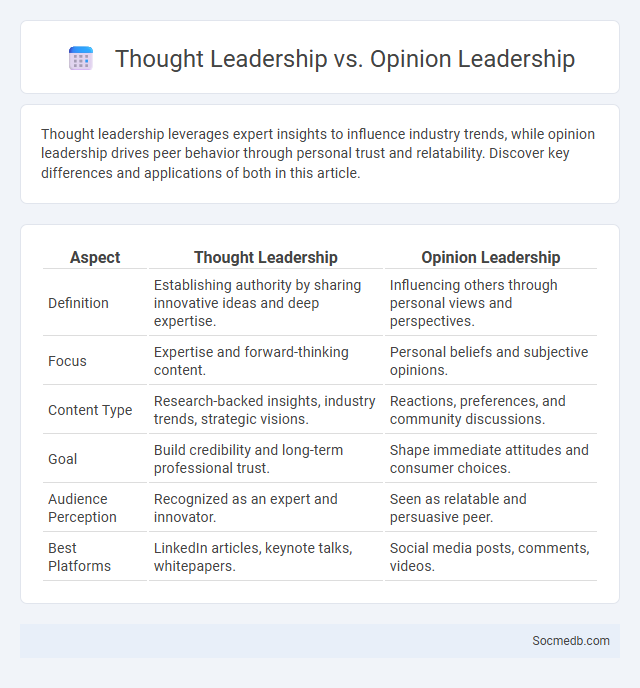
Photo illustration: Thought Leadership vs Opinion Leadership
Thought leadership leverages expert insights to influence industry trends, while opinion leadership drives peer behavior through personal trust and relatability. Discover key differences and applications of both in this article.
Table of Comparison
| Aspect | Thought Leadership | Opinion Leadership |
|---|---|---|
| Definition | Establishing authority by sharing innovative ideas and deep expertise. | Influencing others through personal views and perspectives. |
| Focus | Expertise and forward-thinking content. | Personal beliefs and subjective opinions. |
| Content Type | Research-backed insights, industry trends, strategic visions. | Reactions, preferences, and community discussions. |
| Goal | Build credibility and long-term professional trust. | Shape immediate attitudes and consumer choices. |
| Audience Perception | Recognized as an expert and innovator. | Seen as relatable and persuasive peer. |
| Best Platforms | LinkedIn articles, keynote talks, whitepapers. | Social media posts, comments, videos. |
Defining Thought Leadership
Thought leadership on social media involves establishing expertise and influencing a specific industry or niche through consistent, high-quality content that offers unique insights and solutions. Key elements include authentic engagement, originality, and the ability to inspire or challenge audiences, positioning individuals or brands as authorities. Measuring thought leadership impact relies on metrics such as follower growth, content shares, and audience interaction rates, reflecting credibility and trust within the digital community.
What is Opinion Leadership?
Opinion leadership refers to the ability of individuals to influence the attitudes, beliefs, and behaviors of others within a social network, particularly on social media platforms like Instagram, Twitter, and TikTok. These leaders often possess expertise, credibility, and a large following, enabling them to shape consumer opinions and drive trends through content sharing and engagement. Brands frequently collaborate with opinion leaders, also known as influencers, to enhance marketing strategies and increase brand awareness in targeted demographics.
Key Differences Between Thought Leadership and Opinion Leadership
Thought leadership establishes Your authority and expertise in a specific industry by providing innovative insights and valuable knowledge, whereas opinion leadership relies on personal influence and popularity within a community to sway public views. Thought leaders produce original, research-backed content that shapes industry trends, while opinion leaders often share subjective viewpoints or endorse existing ideas to guide follower behavior. Understanding these distinctions helps You strategize social media engagement by leveraging credibility versus relational influence effectively.
Overlapping Qualities of Thought and Opinion Leaders
Thought and opinion leaders both shape social media discourse through their credible insights and influential perspectives. Your engagement with their content often drives trends and fosters community discussions. Recognizing their overlapping qualities enhances your ability to identify trusted sources and participate meaningfully in online conversations.
The Role of Credibility in Leadership
Credibility in leadership significantly influences how your messages are perceived on social media, impacting follower trust and engagement. Authentic, transparent communication builds a strong online reputation, enhancing your authority and effectiveness as a leader. Consistently providing accurate information and demonstrating expertise fosters loyalty and drives positive interaction across social platforms.
Influence and Authority: Who Leads the Conversation?
Social media platforms are dominated by influencers and authoritative voices who shape trends and public opinion through high engagement and follower counts. Key figures include celebrities, industry experts, and niche content creators who leverage algorithmic favor to amplify their reach. Brands and thought leaders invest strategically in building credibility to maintain leadership in dynamic online conversations.
Channels for Amplifying Leadership
Leveraging social media channels like LinkedIn, Twitter, and industry-specific forums can significantly amplify your leadership presence by showcasing expertise and fostering meaningful connections. Regularly sharing insightful content, engaging in relevant discussions, and participating in live events or webinars enhances visibility and credibility among peers and followers. Consistent interaction on these platforms positions you as a thought leader, driving influence and expanding your professional network.
Measuring the Impact: Thought vs Opinion Leadership
Measuring the impact of social media in thought versus opinion leadership requires analyzing engagement metrics such as shares, comments, and reach alongside sentiment analysis to gauge audience influence. Thought leadership drives strategic conversations by providing innovative ideas and expertise, while opinion leadership sways public perception through personal viewpoints and endorsements. Your social media strategy should leverage data analytics tools to differentiate and enhance both leadership types for maximum brand authority and trust.
Content Creation Strategies for Each Leadership Style
Effective content creation strategies vary based on leadership styles, with transformational leaders benefiting from inspirational storytelling that engages your audience emotionally, while transactional leaders thrive using clear, goal-oriented posts that emphasize measurable outcomes. Servant leaders excel by highlighting community-driven content and authentic interactions, fostering trust and loyalty through consistent, value-focused messaging. Adopting tailored content approaches aligned with your leadership style ensures maximum engagement and reinforces your unique brand identity on social media platforms.
Choosing the Right Leadership Path for Your Brand
Selecting the right leadership path for your brand on social media involves understanding your target audience, aligning your content strategy with your brand values, and leveraging data analytics to track engagement and growth. Effective leaders prioritize authenticity, consistent messaging, and active community management to build trust and foster brand loyalty. Using tools like social listening and audience segmentation allows brands to tailor their leadership approach to meet evolving consumer expectations and market trends.
 socmedb.com
socmedb.com